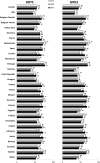Trends from 2002 to 2010 in Daily Breakfast Consumption and its Socio-Demographic Correlates in Adolescents across 31 Countries Participating in the HBSC Study
- PMID: 27027743
- PMCID: PMC4814074
- DOI: 10.1371/journal.pone.0151052
Trends from 2002 to 2010 in Daily Breakfast Consumption and its Socio-Demographic Correlates in Adolescents across 31 Countries Participating in the HBSC Study
Abstract
Breakfast is often considered the most important meal of the day and children and adolescents can benefit from breakfast consumption in several ways. The purpose of the present study was to describe trends in daily breakfast consumption (DBC) among adolescents across 31 countries participating in the HBSC survey between 2002 to 2010 and to identify socio-demographic (gender, family affluence and family structure) correlates of DBC. Cross-sectional surveys including nationally representative samples of 11-15 year olds (n = 455,391). Multilevel logistic regression analyses modeled DBC over time after adjusting for family affluence, family structure and year of survey. In all countries, children in two-parent families were more likely to report DBC compared to single parent families. In most countries (n = 19), DBC was associated with family affluence. Six countries showed an increase in DBC (Canada, Netherland, Macedonia, Scotland, Wales, England) from 2002. A significant decrease in DBC from 2002 was found in 11 countries (Belgium Fr, France, Germany, Croatia, Spain, Poland, Russian Federation, Ukraine, Latvia, Lithuania and Norway), while in 5 countries (Portugal, Denmark, Finland, Ireland, Sweden) no significant changes were seen. Frequency of DBC among adolescents in European countries and North America showed a more uniform pattern in 2010 as compared to patterns in 2002. DBC increased significantly in only six out of 19 countries from 2002 to 2010. There is need for continued education and campaigns to motivate adolescents to consume DBC. Comparing patterns across HBSC countries can make an important contribution to understanding regional /global trends and to monitoring strategies and development of health promotion programs.
Conflict of interest statement
Figures
Similar articles
-
The Correlation between Adolescent Daily Breakfast Consumption and Socio-Demographic: Trends in 23 European Countries Participating in the Health Behaviour in School-Aged Children Study (2002-2018).Nutrients. 2023 May 24;15(11):2453. doi: 10.3390/nu15112453. Nutrients. 2023. PMID: 37299415 Free PMC article.
-
Breakfast consumption and its socio-demographic and lifestyle correlates in schoolchildren in 41 countries participating in the HBSC study.Int J Public Health. 2009 Sep;54 Suppl 2(Suppl 2):180-90. doi: 10.1007/s00038-009-5409-5. Int J Public Health. 2009. PMID: 19639257 Free PMC article.
-
Family structure and breakfast consumption of 11-15 year old boys and girls in Scotland, 1994-2010: a repeated cross-sectional study.BMC Public Health. 2012 Mar 22;12:228. doi: 10.1186/1471-2458-12-228. BMC Public Health. 2012. PMID: 22440153 Free PMC article.
-
Sixteen-year trends in fruit consumption and related socioeconomic inequalities among adolescents in Western European countries.Eur J Nutr. 2023 Dec;62(8):3287-3296. doi: 10.1007/s00394-023-03199-5. Epub 2023 Aug 16. Eur J Nutr. 2023. PMID: 37584785
-
Dietary Iron Intake in Women of Reproductive Age in Europe: A Review of 49 Studies from 29 Countries in the Period 1993-2015.J Nutr Metab. 2019 Jun 13;2019:7631306. doi: 10.1155/2019/7631306. eCollection 2019. J Nutr Metab. 2019. PMID: 31312532 Free PMC article. Review.
Cited by
-
Trend in Breakfast Consumption among Primary School Children in Italy.Nutrients. 2023 Oct 31;15(21):4632. doi: 10.3390/nu15214632. Nutrients. 2023. PMID: 37960286 Free PMC article.
-
Skipping Breakfast and a Meal at School: Its Correlates in Adiposity Context. Report from the ABC of Healthy Eating Study of Polish Teenagers.Nutrients. 2019 Jul 11;11(7):1563. doi: 10.3390/nu11071563. Nutrients. 2019. PMID: 31336699 Free PMC article.
-
Nutritional Quality of Breakfast Consumed by the Low-Income Population in Brazil: A Nationwide Cross-Sectional Survey.Nutrients. 2019 Jun 24;11(6):1418. doi: 10.3390/nu11061418. Nutrients. 2019. PMID: 31238519 Free PMC article.
-
Inequities in dietary intake and eating behaviours among adolescents in Canada.Can J Public Health. 2024 Jun;115(3):507-520. doi: 10.17269/s41997-024-00854-0. Epub 2024 Feb 21. Can J Public Health. 2024. PMID: 38381304 Free PMC article.
-
Association between Breakfast Meal Categories and Timing of Physical Activity of Japanese Workers.Foods. 2022 Aug 28;11(17):2609. doi: 10.3390/foods11172609. Foods. 2022. PMID: 36076795 Free PMC article.
References
-
- Affenito SG. Breakfast: a missed opportunity. J Am Diet Assoc. 2007;107: 565–569. - PubMed
-
- Keski-Rahkonen A, Kaprio J, Rissanen A, Virkkunen M, Rose RJ. Breakfast skipping and health-compromising behaviors in adolescents and adults. Eur J Clin Nutr. 2003;57: 842–53. - PubMed
-
- Rampersaud GC, Pereira MA, Girard BL, Adams J, Metzl JD. Review–Breakfast habits, nutritional status, body weight, and academic performance in children and adolescents. J Am Diet Assoc. 2005;105: 743–60. - PubMed
-
- Deshmukh-Taskar PR, Nicklas TA, O’Neil CE, Keast DR, Radcliffe JD, et al. The relationship of breakfast skipping and type of breakfast consumption with nutrient intake and weight status in children and adolescents: the National Health and Nutrition Examination Survey. 1999–2006. J Am Diet Assoc. 2010;110(6): 869–78. 10.1016/j.jada.2010.03.023 - DOI - PubMed
Publication types
MeSH terms
LinkOut - more resources
Full Text Sources
Other Literature Sources


